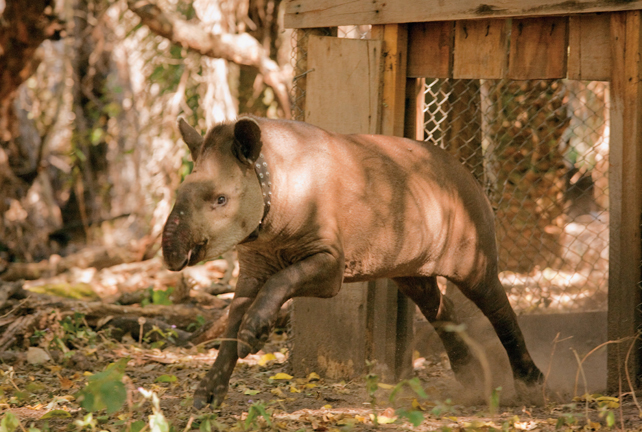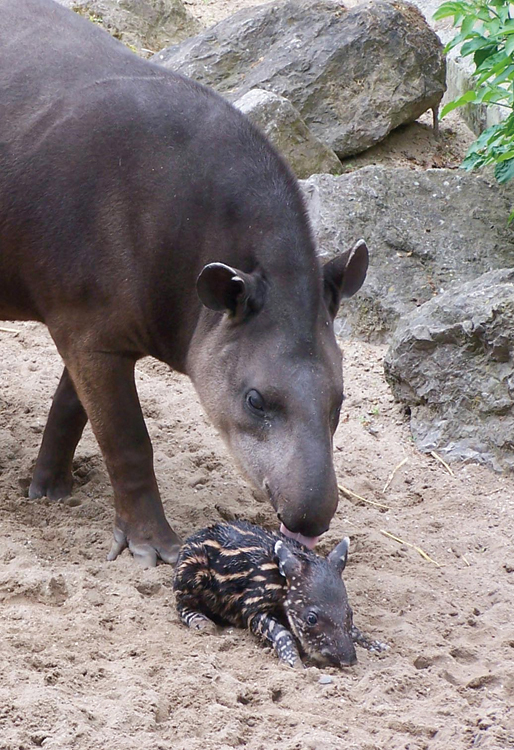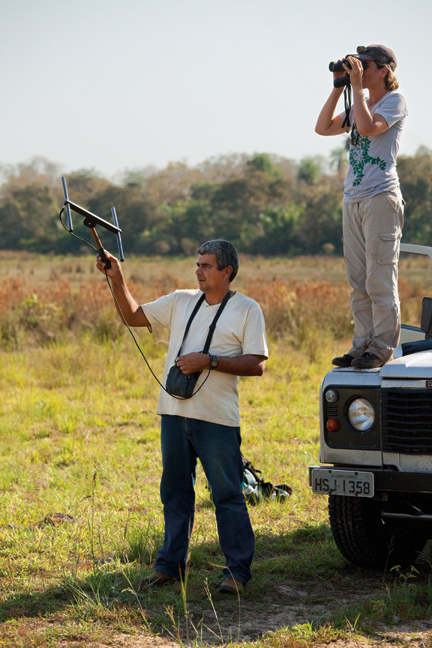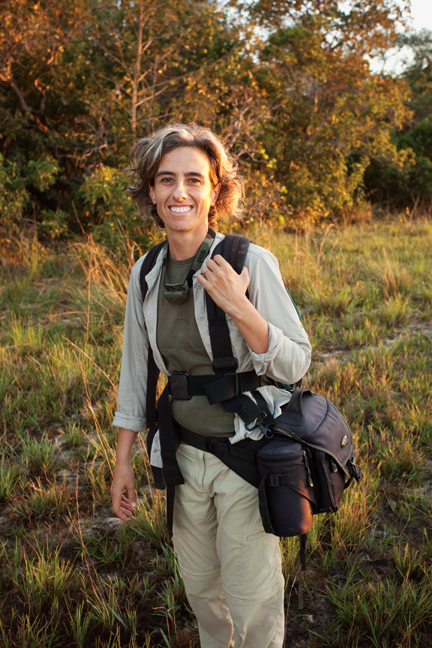Tapir Scientist
Air Date: Week of September 13, 2013

Felippe bolts for freedom. (photo: Sy Montgomery)
Sy Montgomery spends her life exploring the world of animals and writing about her adventures. She tells host Steve Curwood about her latest book, chronicling an expedition with a scientist trying to save South America's largest mammal, the endangered tapir.
Transcript
CURWOOD: It's Living on Earth, I'm Steve Curwood.
We can count on writer Sy Montgomery to bring us funny and fascinating stories of her animal encounters in just about every corner of the globe. Over the years she’s swum with pink dolphins in the Amazon, stalked snow leopards in Mongolia and hugged a giant Pacific octopus - when she wasn’t at home with her 750 pound pet pig, Christopher Hogwood. And recently I caught up with her to hear about her expedition with photographer Nic Bishop to the vast wetlands of Brazil called the Pantanal. Sy was there to chronicle the work of Patti Medici, a scientist who is trying to save South America’s largest mammal, the tapir.
MONTGOMERY: There’s several different species of tapirs but the one that I was writing about is the most common tapir. They look like something prehistoric, and they are, because they have not changed in five million years when we had mastodons running around North America. These guys, they look a little bit like an elephant because they have a trunk - a flexible trunk - although it’s shorter. They look a little bit like a rhino. They are related to horses, and they whinny like horses. But unlike horses, they don’t have hooves. They have toes, and they have different numbers of toes on their front and back feet. They are beautiful; they are stunning, and they’re a keystone species for some of the most endangered habitats in the world, including Brazil’s Pantanal - it’s the largest wetland - and in Southeast Asia as well.
CURWOOD: So this is in South America, the Pantanal, this is a vast grassland.

Leticia and her first calf, Cali. All species of tapirs—even the black and white Malayan tapir—have spots and stripes as babies. (photo: Sy Montgomery)
MONTGOMERY: Right. They call it the Everglades on steroids. [LAUGHS] It’s an amazing, amazing place. And the numbers of birds and reptiles that you see...it’s just a great place to be, full of the voices of strange birds, giant rodents - the world’s largest rodent, the capybara; there’s all kinds of wonderful snakes and caymans, but the birds I think are one of the most astonishing things.
CURWOOD: So tapirs, they’re really important to the ecosystem...why?
MONTGOMERY: Well, one reason is that they love to eat fruit, and they eat some of the fruits that nobody else does. Then they conveniently plant the seeds of those fruits because they eat the seeds along with the pulp. So they eat in one place and they poop in another, and often they’ll go uphill, which a seed would never otherwise do. So they act as gardeners in the forest, and for this reason, they are thought to be super, super important in the ecosystems where they live. But the problem was, until Patti Medici got started studying these, no one knew anything about these mammals, even though they’re the largest mammal in South America, and so crucial to the ecosystems.
CURWOOD: So tell me about this team of scientists led by Patti Medici that you followed around?
MONTGOMERY: Patti Medici was the head of the team. She’s Brazilian, and she started out studying primates, but she felt they were well-studied, and she wanted to go into something new. And she thought, tapirs are just so important, no one knows anything about them. She was going to try to do what no one else succeed in doing before, and study them in each of the habitats where they occur. She goes out about once a month during the dry season in the Pantanal to study them. And for the expedition that Nic Bishop, the photographer I work with, and I joined, there were several other people. It was a multinational, multilingual group.

With radio telemetry and binoculars, Jośe and Pati search for one of the collared tapirs. (photo: Sy Montgomery)
CURWOOD: Sy, now, when you go out on these expeditions, they always turn into a bit of a mystery. There’s a hunt, and you try to find these creatures. These tapirs, they’re big, you say, they’re 400 pounds, but they’re shy, hard to find.
MONTGOMERY: Yes, they’re very shy and hard to find, and they can be extremely quiet, believe it or not, sneaking around on their toes in the forest, or in the grassland. And what we needed to do to study them was to get radio collars on them, and you can’t just walk up to a tapir and ask it to do that. What you usually have to do is to dart them, and there’s two ways to do this. You can entice them into a box trap, which Patti was trying to do - we set up box traps all over her study area. But she also wanted to dart some of them without sending them into a box trap because you don’t want to just get and study the tapirs who are not afraid of box traps.
CURWOOD: Take me through a typical day for a tapir researcher.
MONTGOMERY: Oh boy, none of our days were very typical. A lot of our days were frustrating because when you’re working in the field it’s not like in the laboratory. In the laboratory it’s all about control, but in the field, it’s all about surprise.
We realized that tapirs were going to be hard to find, but we didn’t realize how hard they were going to be to dart, and even when they were in the traps, we were having trouble with the darting working out. We didn’t know why, but several tapirs just wouldn’t go down when we darted them. And we would give them a little more of medicine, and then they wouldn’t go to sleep. Well, you wouldn’t want to give them so much that they’re actually ill. So we had to let some of those guys go.
Other days, we had so many tapirs in the traps that we were afraid we wouldn’t get to them all. It got to be over 90 degrees by 9 o’clock in the morning when were working, and you don’t want to keep a tapir in a trap too long - that’s dangerous.
Other things that happened that were kind of scary and dramatic was we really wanted to be able to get one that wasn’t in the trap because you’re getting somebody that does a different behavior, and Gabriel, our main darter, was working very, very hard at this, but the tapirs always seemed to get away from us.
.jpg)
The team collars a new, healthy tapir. (photo: Sy Montgomery)
Well, the one he got, when it was starting to go sleep, it started going toward water. They’re fantastic swimmers, but you don’t want to send someone to water when they’ve been darted with tranquilizer. And so the whole team ended up getting out and trying to herd this darted tapir away from the water - a 400 pound animal who’s generally very gentle, but they can kill you quite easily if they want to. And if they’re not in their right mind, who knew what would happen. I was so impressed with the bravery of the whole team, because what was most important to them was that they weren’t going to hurt a tapir, and they wanted to prevent him from lying down in the water and drowning, which was successful.
CURWOOD: So looking in your book, you ran into a lot of tapirs out there. What kinds of things did you do with them?
MONTGOMERY: Well, in some cases, we were meeting up with some of Patti’s old friends. Some of them were already collared. She had collared quite a few, but the collars fall off. And also it’s just good to check in with your tapir from time to time.
Others, we knew from seeing their images on camera traps, cameras that are latched to a tree or post, and they snap pictures of all these tapirs as they come and go to areas. And you get to know, oh my gosh, this one has had a baby, and oh goodness, this male is hanging out with this female...I wonder if they’re mating, and this male is following that male...I wonder if they’re chasing him away, and we were following some of them with radio telemetry too. So we got to know, over a dozen tapirs, and their history from these little glimpses that we got of them.

Patricia Medici, the chief field scientist followed in the book, started research on tapirs after first studying primates. (photo: Sy Montgomery)
CURWOOD: So in the end, how did these researchers fare? How successful do you think they were in getting the data they wanted?
MONTGOMERY: Patti said that even though we had a really rocky start and some scary moments, scary that we weren’t going to get a tapir, scary that a tapir was going to get hurt, scary that we almost stepped on a really venomous snake, still this was the most successful campaign ever in terms of getting tons of data. We collected tapir poop, which is extremely important, tapir ticks, also very important, tons, thousands of camera trap photos, we put collars on tapirs who’d never been collared before, we microchipped one of them, and we met up with some of her old friends. So it was an incredible whirlwind two weeks.
CURWOOD: OK. Dangerous snakes you mentioned.
MONTGOMERY: Oh yeah. [LAUGHS] Oh gosh.
CURWOOD: How dangerous was this snake?
MONTGOMERY: This was a snake whose bite is described as dying by inches. It was a Fer-de- lance, they are one of the world’s most venomous snakes, and we were out in the middle of nowhere, the Pantanal. And one of our first nights there, we were out walking in the moonlight looking for tapirs, hadn’t found any. We were jet-lagged, we were tired, and since we just got there, we didn’t want to use up our flashlight batteries so we were walking by moonlight, not using our flashlights. We were walking through an area where there had been lots of cows. There were these round cow pats, and we were so tired we were kicking the cow pats, but one of the cow pats wasn’t a cow pat. It was a coiled Fer-de-lance.
CURWOOD: Oooh my! How close?
MONTGOMERY: We were extremely close. We could have kicked it. The only reason we didn’t, and then, of course, would have had every right to bite us, was the photographer for this book, Nic Bishop, had just done a book on snakes, and his head was in snake mode, and we so nearly stepped on this snake. But it was thrilling to see it.
CURWOOD: You’ve written more than a dozen books. They’re pretty much always about animals. Why?
MONTGOMERY: Well, most of animate creation isn’t humans. I like humans, I married one, and some of my best friends are humans, but some of my best friends are not humans. And there’s lots of people writing about humans. I think there’s been a dangerous disconnect between us and the rest of animate creation. So that’s why I write about those who Farley Mowat calls ‘the others’.
And also, it’s because you can learn so much from someone who’s different from you. Animals, they share a lot of the same emotions that we have I believe neurotransmitters are highly conserved across taxa which means they have the same brain chemistry that we do. A clam that’s being opened will show the same neurotransmitters in its bloodstream - we don’t call their bloodstream blood - that a person having a heart attack does. They’re panicking.
So they have a lot of the same emotions, but they have all kinds of other abilities, you know, octopus can taste with all of their skin, crickets can hear with their knees, a dog can smell someone that passed by a week, two weeks, a month ago. They have all these great abilities. Birds can see infrared light. So animals have always been my teachers, my mentors. And there’s that great Buddhist saying, ‘when the student is ready, the teacher will appear.’ The teachers that have appeared to me have had four legs or six or eight or none, or fur or scales.
CURWOOD: Sy, you usually have a picture of yourself in your books, but there’s a Sy Montgomery, but it doesn’t look a whole lot like you in this book.
MONTGOMERY: No, and I’m hoping this is what comes up when people do Google images for Sy Montgomery. There’s a much more glamorous Sy Montgomery out there. It’s a beautiful, fat, sleek, gorgeous female tapir that was named after me after I had left.
CURWOOD: Sy Montgomery’s latest book is called The Tapir Scientist: Saving South America’s Largest Mammal.
CURWOOD: Thanks so much, Sy.
MONTGOMERY: Oh, what a pleasure to see you again.
CURWOOD: There are pictures and more at our website, LOE.org
Links
Video of Patricia Medici lecture in 2011
Living on Earth wants to hear from you!
Living on Earth
62 Calef Highway, Suite 212
Lee, NH 03861
Telephone: 617-287-4121
E-mail: comments@loe.org
Newsletter [Click here]
Donate to Living on Earth!
Living on Earth is an independent media program and relies entirely on contributions from listeners and institutions supporting public service. Please donate now to preserve an independent environmental voice.
NewsletterLiving on Earth offers a weekly delivery of the show's rundown to your mailbox. Sign up for our newsletter today!
 Sailors For The Sea: Be the change you want to sea.
Sailors For The Sea: Be the change you want to sea.
 The Grantham Foundation for the Protection of the Environment: Committed to protecting and improving the health of the global environment.
The Grantham Foundation for the Protection of the Environment: Committed to protecting and improving the health of the global environment.
 Contribute to Living on Earth and receive, as our gift to you, an archival print of one of Mark Seth Lender's extraordinary wildlife photographs. Follow the link to see Mark's current collection of photographs.
Contribute to Living on Earth and receive, as our gift to you, an archival print of one of Mark Seth Lender's extraordinary wildlife photographs. Follow the link to see Mark's current collection of photographs.
 Buy a signed copy of Mark Seth Lender's book Smeagull the Seagull & support Living on Earth
Buy a signed copy of Mark Seth Lender's book Smeagull the Seagull & support Living on Earth

